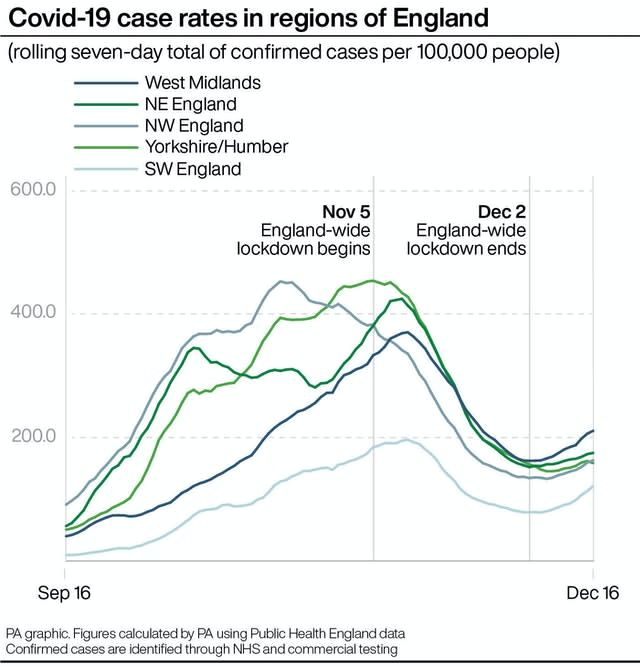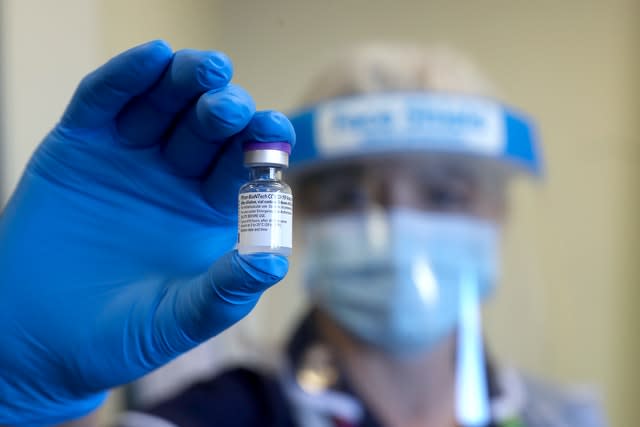New Covid-19 variant – key questions answered
Scientists have found the new variant of Covid-19 spreads more rapidly, leading to harsher restrictions in some parts of England less than a week before Christmas.
There is currently no evidence that the new strain causes higher mortality rates or affects vaccines and treatments, although some data shows it infects more children.
Here the PA news agency answers some of the key questions about the variant:
– Is this something unusual?
There have been many mutations in the virus since it emerged in 2019. This is to be expected – SARS-CoV-2 is an RNA virus and these viruses mutate and change.
It has been named VUI-202012/01, the first variant under investigation in December.
– How fast is it spreading?
Professor Neil Ferguson, a member of the Government’s New and Emerging Respiratory Virus Threats advisory group (NervTag), said estimates showing the new strain is up to 70% more transmissible was based on less data.
It was the figure given by Prime Minister Boris Johnson at a press conference in Downing Street on Saturday, however Prof Ferguson said there was “quite considerable uncertainty around it”.
Prof Ferguson added: “Our latest estimates, both on genetic analysis and epidemiological analysis, would point to 50% to 70% being the sort of multiplicative factor by which you could multiply transmission.”
– Is the variant affecting more children?
Prof Ferguson said there is an indication that the new variant of coronavirus infected more children.
He said: “There are other epidemiologically interesting trends with the virus, there is a hint that it has a higher propensity to infect children … but we haven’t established any sort of causality on that, but we can see that in the data.”
However, fellow NervTag member Professor Wendy Barclay said the virus was not specifically attacking children, adding: “We know that SARS-CoV-2, as it emerged as a virus was not as efficient in infecting children as it was adults.
“If the (new) virus is having an easier time of finding an entrance cell then that would put children on a more level playing field.”

– Is this something to be worried about?
If the virus spreads faster it will be harder to control.
Prof Barclay said: “People infected with this variant tend to have higher levels of virus in their swabs.”
But she said there is no evidence yet to suggest the new strain is making people more ill compared with other variants.
And there have already been various strains of Covid-19 with no real consequence.
The Covid-19 Genomics UK (COG-UK) consortium said it is difficult to predict whether any given mutation is important when it first emerges, and that it would take “considerable time and effort to test the effect of many thousands of combinations of mutations”.
– When did the variant emerge?
The new strain of coronavirus in the South East was identified in September, Maria Van Kerkhove, Covid-19 technical lead at the World Health Organisation (WHO), said.
Meanwhile, Dr Susan Hopkins, of Public Health England (PHE), said that the variant had been identified in October from a sample taken in September.
It has led to some questioning why the Government had not taken action sooner.
Conservative former minister Sir Desmond Swayne questioned the timing of the Prime Minister’s announcements, saying: “They’ve been looking at it since September, and how convenient when Parliament went into recess on Thursday, suddenly they were then able to produce this revelation.”
– Where else has the variant been detected?
In the UK, Prof Ferguson said there is evidence of a hotspot in the North West of England.
He said: “We have yet to fully determine what’s going on in South Wales because there is a hint this variant may partly be responsible for the surge in cases there.

Meanwhile, Dr Hopkins added: “We have a small hotspot that we’re tracking at the moment in Cumbria.
“It’s a very small number of cases and they sequence very small amounts, so there’s not very much reliable around that estimate, but we have been speaking to the local team and asking them to investigate further.”
– What about globally?
Elsewhere, the variant has been identified in Denmark, the Netherlands and Australia.
Calum Semple, professor of outbreak medicine at the University of Liverpool, said the variant will become the dominant global strain.
He said: “Because the virus has the evolutionary advantage in transmitting more quickly, it will out-compete all the other strains.”
– Will this mean another national lockdown?
Prof Ferguson said what happens with current restrictions will inform policy on future measures.
He said: “What we see happen in the next two weeks when the country is quite close to lockdown and schools are closed and the areas with the highest frequency of this virus are in Tier 4, which is basically equivalent to the last lockdown, what happens to the virus in that period and what happens to it in other areas which are still in Tiers 3 and 2 will inform policy going forward.”
The Government’s chief scientific adviser, Sir Patrick Vallance, suggested measures across the country will be tightened in the coming weeks.
He said: “I think it is likely that this will grow in numbers of the variant across the country and I think it’s likely, therefore, that measures will need to be increased in some places, in due course, not reduced.”
– Is it the first novel strain detected in the UK?
A number of variants have been detected using sequencing studies in the UK.
A specific variant (the D614G variant) has previously been detected in western Europe and North America, which is believed to spread more easily but not cause greater illness.
But it is thought this is the first strain that will be investigated in such detail by PHE.
– How confident are we this won’t affect vaccine efficacy?

Scientists have said it is still too early to tell how a vaccine will behave with the new strain.
The vaccine produces antibodies against many regions in the spike protein, and it is unlikely a single change would make the vaccine less effective.
However, this could happen over time as more mutations occur, as is the case every year with flu.
Prof Semple said: “The flu vaccine typically contains three or four flavours of the influenza virus and we simply pick on a best-guess basis each season, and then people that make the vaccines scale up in a timely manner.”
Prof Barclay said the quickest way to analyse the effect on the vaccine is to look at the antibodies developed in people who have had the jab.
She added: “And that work is under way in several laboratories around the UK at the moment. And (scientists) will reveal whether or not there’s a difference.”
– So what are the scientists doing now?
Scientists will be growing the new strain in the lab to see how it responds.
This includes looking at whether it produces the same antibody response, how it reacts to the vaccine, and modelling the new strain.
It could take up to two weeks for this process to be complete.
COG-UK is carrying out random sequencing of positive samples across the UK to compile a sequencing coverage report, which is sent to each of the four public health agencies each week.
– What examples are there of other virus strains?
The Danish government culled millions of mink after it emerged that hundreds of Covid-19 cases in the country were associated with SARS-CoV-2 variants associated with farmed mink – including 12 cases with a unique variant, reported on November 5.
In October a study suggested that a coronavirus variant that originated in Spanish farmworkers spread rapidly throughout Europe and accounted for most UK cases.
The variant, called 20A.EU1, is known to have spread from farmworkers to local populations in Spain in June and July, with people then returning from holiday in Spain most likely playing a key role in spreading the strain across Europe.


